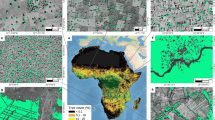Abstract
Natural resources are a major source of wealth of Russia and a guarantee of its prosperity and special role in the world. In addition, we should not forget that they refer not only to mineral deposits but also to the great diversity of bioresources. The vast territory and a large number of ecosystems not only distinguish Russia among other countries but also lay a great responsibility on it to maintain the sustainability of the biosphere at the national, regional, and planetary levels. The problem of forestland protection, which is especially urgent because of its importance for biospheric interrelations and, consequently, for the survival of humanity, is hard to overestimate.
Similar content being viewed by others
References
A meeting of the Presidium of the State Council on improving the efficiency of the forest complex. Verbatim report. www.kremlin.ru/news/17876
A. S. Isaev and V. Ya. Ryapolov, “Analysis of the landscape-ecological confinedness of Siberian silkworm loci using aerospace survey,” in Studying Taiga Landscapes by Remote-Sensing Method (Nauka, Novosibirsk, 1976) [in Russian].
Aerospace Monitoring of Forests, Ed. by A. S. Isaev and V. I. Sukhikh (Nauka, Moscow, 1991) [in Russian].
A. S. Isaev, G. N. Korovin, V. I. Sukhikh, et al., Ecological Problems of Carbon Dioxide Absorption by Reforestation and Forestation in Russia (Tsentr Ekol. Politiki Rossii, Moscow, 1995) [in Russian].
A. S. Isaev and G. N. Korovin, “Large-scale changes in Eurasian boreal forests and methods of their evaluation using space information,” Lesovedenie, No. 2 (2003).
S. A. Bartalev, A. Belward, D. V. Ershov, and A. S. Isaev, “A new SPOT4-VEGETATION derived land cover map of northern Eurasia,” Int. J. Remote Sensing 24, 1977 (2003).
S. A. Bartalev, D. V. Ershov, G. N. Korovin, R. V. Kotel’nikov, E. A. Lupyan, and V. E. Shchetinskii, “The main functionalities and structure of the Forest Fire Satellite Monitoring Information System of the Russian Federal Forestry Agency (SMIS-Rosleshoz),” Sovr. Probl. Distantsionnogo Zondirovaniya Zemli Kosmosa 7(2), 97 (2010).
S. A. Bartalev, D. V. Ershov, A. S. Isaev, and E. A. Lupyan, “The main objectives and perspectives of developing a system for global satellite monitoring of forests,” Lesovedenie, No. 6 (2011).
Monitoring the Biological Diversity of Russia’s Forests: Methodology and Methods, Ed. by A. S. Isaev (Nauka, Moscow, 2008) [in Russian].
Diversity and Dynamics of Russia’s Forest Ecosystems, 2 vols., Ed. by A. S. Isaev (Tovarishchestvo po Nauchnym Izdaniyam KMK, Moscow, 2012, 2013) [in Russian].
N. V. Lukina, “Biodiversity and ecosystemic functions of forests,” in Diversity and Dynamics of Russia’s Forest Ecosystems, vol. 2, Ed. by A. S. Isaev (Tovarishchestvo po Nauchnym Izdaniyam KMK, Moscow, 2012) [in Russian].
http://www.cbd.int/forest/about.shtml. Cited September 3, 2009.
National indicators, monitoring and reporting for the Strategic Plan for Biodiversity 2011–2020: A review of experience and recommendations in support of the CBD Ad Hoc Technical Expert Group (AHTEG) on indicators for the Strategic Plan 2011–2020. http://www.bipindicators.net/LinkClick.aspx?fileticket=lE44f1S4BKQ%3D&tabid=430
Criteria and indicators for the conservation and sustainable management of temperate and boreal forests. The Montreal process. Fourth Edition, October 2009. http://www.rinya.maff.go.jp/j/kaigai/pdf/2009p-4.pdf
State of Europe’s Forests 2011. Status and Trends in Sustainable Forest Management in Europe. http://www.foresteurope.org/documentos/State-of-Europes-Forests-2011-Report-Revised-November-2011.pdf
S. A. Bartalev, V. A. Egorov, E. A. Loupian, and S. A. Khvostikov, “A new locally-adaptive classification method LAGMA for large-scale land cover mapping using remote-sensing data,” Remote Sensing Lett. 5(1), 55 (2014).
S. A. Bartalev, V. A. Egorov, D. V. Ershov, et al., “Mapping of Russia’s vegetation cover using MODIS satellite spectroradiometer data,” Sovremennye Problemy Distantsionnogo Zondirovaniya Zemli iz Kosmosa, No. 4 (2011).
E. A. Lupyan, I. Yu. Savin, S. A. Bartalev, et al., “Satellite service of monitoring vegetation status (“Vega”),” Sovremennye Problemy Distantsionnogo Zondirovaniya Zemli iz Kosmosa, No. 1 (2011).
Author information
Authors and Affiliations
Corresponding author
Additional information
Original Russian Text © A.S. Isaev, S.A. Bartalev, E.A. Lupyan, N.V. Lukina, 2014, published in Vestnik Rossiiskoi Akademii Nauk, 2014, Vol. 84, No. 12, pp. 1073–1079.
Rights and permissions
About this article
Cite this article
Isaev, A.S., Bartalev, S.A., Lupyan, E.A. et al. Earth observations from satellites as a unique instrument to monitor Russia’s forests. Her. Russ. Acad. Sci. 84, 413–419 (2014). https://doi.org/10.1134/S1019331614060094
Published:
Issue Date:
DOI: https://doi.org/10.1134/S1019331614060094




